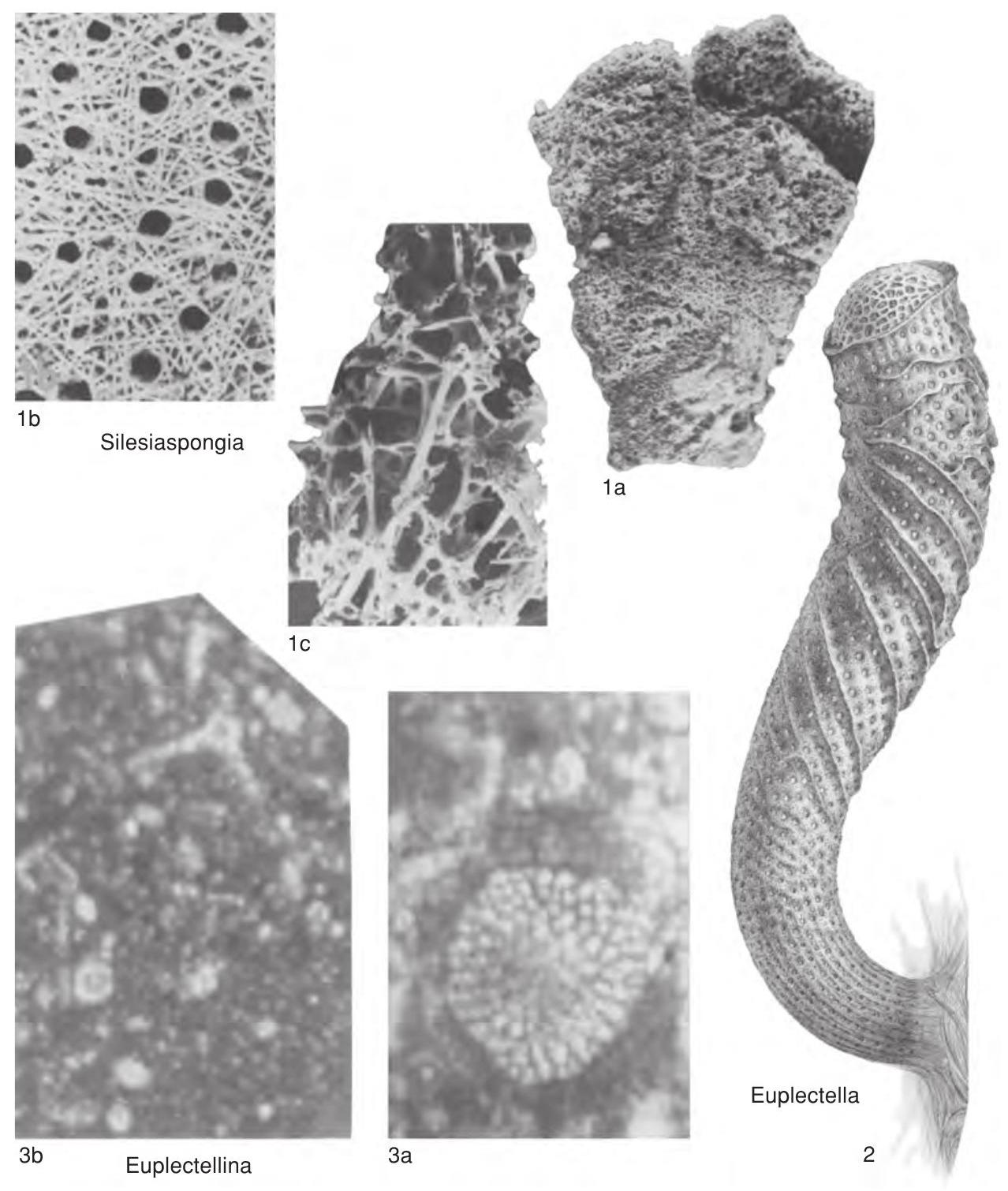Welcome to the Treatise on Invertebrate Paleontology!
Please enter a genera name to retrieve more information.

Euplectella
Classification
Phylum:
Porifera
Class:
Porifera - Class, Order and Family Uncertain
Subclass:
Hexasterophora
Order:
Lyssacinosa
Family:
Euplectellidae
Subfamily:
Euplectellinae
Formal Genus Name and Reference:
Euplectella OWEN, 1841, p. 3
Type Species:
E. aspergillian, OD
Images
(Click to enlarge in a new window)
Fig. 297, 2. *E. aspergillian, Philippine Islands, near Zebu; side view showing upper sieve plate, ridged main body, and root tuft, X0.5 (Schulze, 1887b).
Synonyms
Geographic Distribution
cosmopolitan
Age Range
Beginning Stage in Treatise Usage:
Holocene
Beginning International Stage:
Greenlandian
Fraction Up In Beginning Stage:
0
Beginning Date:
0.01
Ending Stage in Treatise Usage:
Holocene
Ending International Stage:
Meghalayan
Fraction Up In Ending Stage:
100
Ending Date:
0
Description
Thin-walled, tubular or saccular, with terminal sieve plate and numerous parietal oscula, external surface smooth or ridged transversely; principalia mainly hexactines, pentactines, stauractines, with four rays paratangential and grouped to form longitudinal and transverse bundles; other bundles of spicule rays may take diagonal directions; other megasclere types include tauactines, rhabdodiactines, and others; dermalia swordlike hexactines; gastralia subhexactines or pentactines; hexasters, floricomes, graphicones, and oxyhexasters or oxyasters. Parenchymal skeleton loose or rigid in lower part or throughout, including sieve plate. [Supposed Miocene occurrence was recorded by DE LAUBENFELS , 1955, who provided no evident authority for citation.]
References
Owen, R. 1841. On the new genus and species of sponge (Euplectella aspergillum). Proceedings of the Zoological Society 1841:3.
Museum or Author Information
Classification
Phylum:
Porifera
Class:
Porifera - Class, Order and Family Uncertain
Subclass:
Hexasterophora
Order:
Lyssacinosa
Family:
Euplectellidae
Subfamily:
Euplectellinae
Formal Genus Name and Reference:
Euplectella OWEN, 1841, p. 3
Type Species:
E. aspergillian, OD
Images
(Click to enlarge in a new window)
Fig. 297, 2. *E. aspergillian, Philippine Islands, near Zebu; side view showing upper sieve plate, ridged main body, and root tuft, X0.5 (Schulze, 1887b).
Synonyms
Geographic Distribution
cosmopolitan
Age Range
Beginning Stage in Treatise Usage:
Holocene
Beginning International Stage:
Greenlandian
Fraction Up In Beginning Stage:
0
Beginning Date:
0.01
Ending Stage in Treatise Usage:
Holocene
Ending International Stage:
Meghalayan
Fraction Up In Ending Stage:
100
Ending Date:
0
Description
Thin-walled, tubular or saccular, with terminal sieve plate and numerous parietal oscula, external surface smooth or ridged transversely; principalia mainly hexactines, pentactines, stauractines, with four rays paratangential and grouped to form longitudinal and transverse bundles; other bundles of spicule rays may take diagonal directions; other megasclere types include tauactines, rhabdodiactines, and others; dermalia swordlike hexactines; gastralia subhexactines or pentactines; hexasters, floricomes, graphicones, and oxyhexasters or oxyasters. Parenchymal skeleton loose or rigid in lower part or throughout, including sieve plate. [Supposed Miocene occurrence was recorded by DE LAUBENFELS , 1955, who provided no evident authority for citation.]
References
Owen, R. 1841. On the new genus and species of sponge (Euplectella aspergillum). Proceedings of the Zoological Society 1841:3.
